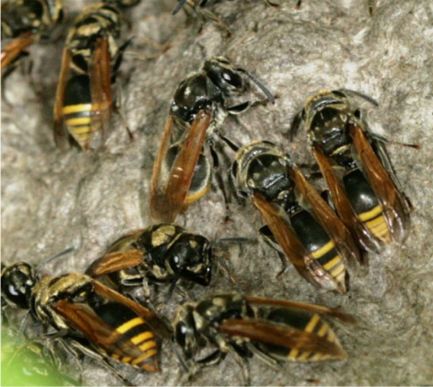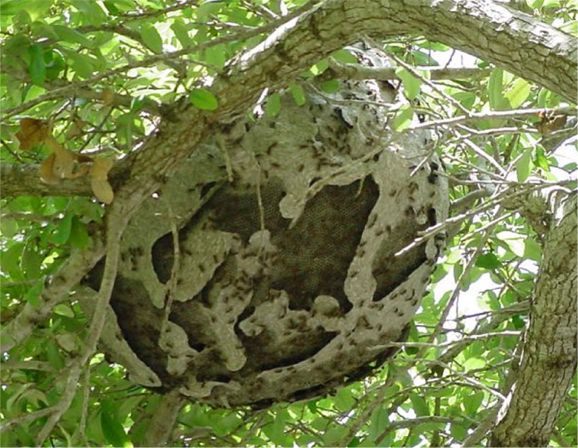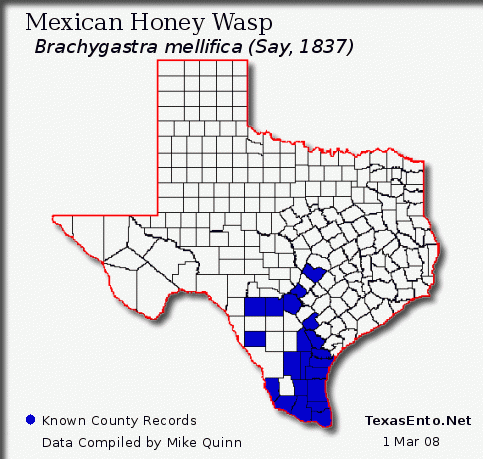
|
Return to Texas Entomology - Compiled by Mike Quinn
One of the very few insects other than bees to produce and store honey

|
Workers are mild mannered by vespid wasp standards but sting hard when sufficiently provoked.
|
|

|
(Nest in a Live Oak tree, photo shot looking straight up)
Photo of downed nest - Photo of Bee Co. nest

|
Bee, Bexar, Brooks, Cameron, Comal, Dimmit, Duval, Hidalgo, Jim Wells, Karnes, Kenedy
Kleberg, Live Oak, Medina, Nueces, San Patricio, Starr, Travis, Uvalde, Willacy, Zapata
Northern-most records from Brackenridge Field Laboratory, near central Austin - Oct. 2016
Range: Roy D. Parker, Professor & Extension Entomologist, (pers. comm., July 2007) writes:
"The Mexican honey wasp is common all over South Texas... I have personally collected them in Kleberg, Nueces, Jim Wells, Duval, San Patricio, and Live Oak counties."
There's also a 100 year old record from Nogales, Arizona (Cameron, 1907). Given the date of the record, it's possible that it was collected south of the border.
Length: 7-9 mm (Hogue, 1993)
Habitat: Occurs in all but the driest habitats (Hogue, 1993)
Life History: Evans & Eberhard (1970):
"Perhaps the most famous of the honey-storing wasps are those of the genus Brachygastra (formerly called Nectarina). In Brazil the honey of Brachygastra lecheguana is gathered from large nests, usually during the Brazilian summer. If the base of the nest is left on the branch, the inhabitants rebuild it in the same place, and the colony can be exploited again the next year. In Mexico the honey of B. lecheguana has commercial value. Wasp farmers-they could properly be called "vespiculturists"-gather young nests and transplant them to places where they can be protected, then periodically oust the inhabitants from the nest with smoke, destroy the nest to obtain the honey, and allow the wasps to return and rebuild the colony. Polybia occidentalis is also used as a source of edible honey in Mexico. Consumers of wasp honey are well-advised to patronize a trustworthy vespiculturist, for the honey of B. lecheguana is occasionally poisonous because of the incorporation of nectar from certain flowers."
Hogue (1993):
The nectar-storing habits of wasps have been perfected by Brachygastra. Their nests contain large stores of a very palatable honey that is widely exploited by humans (Bequaert, 1993). Numerous early accounts discuss the use of honey by the Indians of Mexico and Brazil and leave no doubt about the identity of the insect because of its characteristic nest, which is quite distinct from the nests of stingless bees, the only other common source of native honey in early days. In some areas (e.g. Jalisco), the honey is gathered regularly and even sold on the market. It is strongly scented and said to crystallize more rapidly than bees' honey. Some Indians keep the nests, cutting them when they are small and carrying them to their gardens. The source of the honey is flower nectar gathered by the wasps in bee fashion. When Datura or other toxic blooms are available, the honey may be tainted, and cases of poisoning are not rare.
Nest placement is in the midcanopy of a tree or shrub from 1 to 9 m above ground level. Nests are sparse and difficult to find in native brush but relatively common in suburban settings where they are easily spotted in deciduous trees in winter. (Sugden & McAllen, 1994)
Mature nests are large (40-50 cm long) and ovoid. Frank A. Eischen (pers. comm, July 2007) writes that newly founded nests, in southmost Texas, can reach smallish football size in about 30-40 days. He found occupied nests as long as about three feet and may have been old nests or ones that were unusually successful in finding food.
When filled with honey, they may weigh several kilograms. There are usually only a few large combs (less than 10 but as many as 20) arranged concentrically within the thin envelope. The entrance is located toward the lower end. (Hogue, 1993)
Nest-founding swarms with several hundred individuals are capable of building 10-15 cm diameter nests in a few days. Colonies contain numerous fertile females, or polygynous queens. Liquid food appears to be transferred routinely from foragers to nestmates on the nest surface. The latter then take provisions into the nest. (Sugden & McAllen, 1994)
Hastings et al. (1998) sampled six mature nests collected in the lower Rio Grande Valley with the following characteristics:
Range (n=6)
Wt. (kg) 1.1 to 3.1
No. of wasps 3496 to 18,698 No. of queens 60 to 1529 No. of males 0 to 1017 No. of workers 3310 to 17,454 Sugden & McAllen (1994) in their survey of the lower Rio Grande Valley found that the wasps foraged on a number of common native and exotic flower species for nectar and to collect honeydew from aphids and psyllids. Predation was observed on flower-mining larvae of the weevil Anthonomus aeneolus and on a moth, Alucitidae sp. Robber flies and spiders regularly preyed on adult B. mellifica. Nests were attacked by woodpeckers and probably small mammals that consume brood and honey-containing combs.
The wasps survive off-seasons by feeding on their stores of honey. the nest being perennial and persistent for several years. It appears that the larvae are fed exclusively on the honey and pollen, an unusual diet for wasps.
Workers are mild mannered by vespid wasp standards but sting hard when sufficiently provoked. The sting is barbed and stays in the wound if the victim is a human or other large animal. (Hogue, 1993)
Similar Species:
There are 12 species of Brachygastra (Naumann, 1968) that range from South Texas to Northern Argentina (Hogue, 1993) but only B. mellifica reaches the U.S.
Of the 12 species of Brachygastra, the best known are:
Brachygastra lecheguana (Latreille, 1824)
Brachygastra mellifica (Say, 1837)Pachodynerus nasidens has a similarly yellow-banded abdominal tip, but the first gastral segment is distinctly larger
Weblink: Brachygastra mellifica - Wikipedia
Close-up Photo: Mexican Honey Wasp - San Antonio, Bexar County, Texas - January 6, 2008
Etymology: Brachygastra mellifica
brachy (G). Short
gastr (G). The stomach, belly
melli (L). Honey
fic (L). Make, makingAlternate English name: Mexican Bee
Biography: Thomas Say (1787 – 1834) - Wikipedia
Bibliography:
Bequaert, J. 1933. The Nearctic social wasps of the subfamily Polybiinae (Hymenoptera: Vespidae). Entomologia Americana 13: 87-149.
Borror, D.J. 1960. Dictionary of Word Roots and Combining Forms. National Press Books, Palo Alto. 134 pp.
Cameron, P. 1907. On some North American species of Chartergus. Invertebrata Pacifica 1: 181-183. (Full Text)Evans, H.E. & M.J.West-Eberhard. 1970. The Wasps. University of Michigan Press, Ann Arbor. 265 pp.
Hastings, M.D., D.C. Queller, F. Eischen & J.E. Strassmann. 1998. Kin selection, relatedness and worker control of reproduction in a large-colony epiponine wasp, Brachygastra mellifica. Behavioral Ecology, 9(6): 573-581.
Hogue, C. 1993. Latin American Insects and Entomology. University of California Press, Berkeley. xiv + 594 pp.
Naumann, M.G. 1968. A revision of the genus Brachygastra (Hymenoptera: Vespidae). University of Kansas Science Bulletin, 47: 929-1003.
Richards, O.W. 1978. The social wasps of the Americas, excluding. the Vespinae. British Museum (Natural History), London. 580 pp.
Schwarz, H.F. 1929. Honey wasps. Natural History, 29(4): 421-426.
Soares, J.J. & F.M. Lara. 1994. Predation of Anthonomus grandis Boh. by Brachygastra lecheguana (Latreille) (Hymenoptera: Vespidae). Anais da Sociedade Entomologica do Brasil, 23(1): 135-136
Sugden, E.A. & R.L. McAllen. 1994. Observations on foraging, population and nest biology of the Mexican honey wasp, Brachygastra mellifica (Say) in Texas (Vespidae: Polybiinae). Journal of Kansas Entomological Society, 67(2): 141-155. (JSTOR)
25 April 2017 © Mike Quinn / Texas Entomology